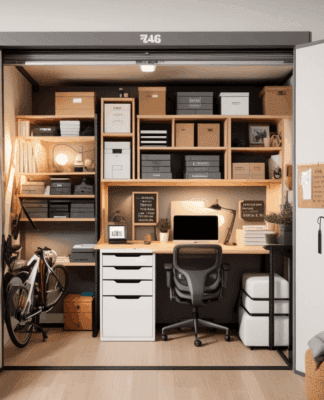Clothing items can withstand the test of time—if they’re properly prepared and cared for. That’s how museums still have garments that are thousands of years old. However, that degree of conservation requires some extremes. Luckily, the clothing you have in storage can last for years if you’re efficient and careful with your storage process. This means choosing the best location for storage, the method in which your clothes are stored, and preparations. Here, we’ll give you some great tips to store clothes for future use.
The Best Place to Store Clothes
Many people assume they can just pack away their clothes and toss them in the basement or attic, but it’s not that easy. To prevent damage, there’s a proper way to store clothes long-term. The attic can fluctuate in temperatures and humidity throughout the year, making it difficult for clothes to stay in good shape season after season. The basement is prone to flooding and more vulnerable to pests, so it can also be a risky space in your home. If you really want to keep your clothes in good condition, offsite storage in a climate-controlled unit is the best option.
Which Method is Best to Store Clothes for Future Use?
Finding the right storage containers to use can be a confusing endeavor. Different materials may require different containers, so if you want to protect your clothes, it’s important to keep a few things in mind.
Garment Bags or Breathable Fabric
One of the best ways to store clothes that are formal or sensitive is using garment bags. However, this will also require that you keep your clothes hung during long-term storage. Luckily, it’s easy to create a hanging space within your storage unit. All you need to do is invest in some free-hanging closet rods. Avoid wire hangers, as they can damage clothing over time. Instead, opt for plastic, wooden, felt, or padded hangers to store clothes long-term.
Plastic Containers
A lot of people put clothes in plastic containers or plastic boxes. This is one of the best storage options, but you need to take a few precautions to ensure you’re storing clothes properly. First, try to find polypropylene or polyethylene storage containers. These will have the numbers 2, 4, or 5 on the bottom within the recycling symbol. You can also use a container labeled HDPE, LDPE, or PP. You want to avoid using any plastic containers made from polyvinyl chloride (PVC), as this can start to degrade the fabric from the by-products it produces over time.
If you decide to store clothes in plastic boxes, you should also make sure to give them time to breathe every now and then. For those interested in using plastic bags for storage (i.e., vacuum-sealed bags), you’ll want to do everything you can to ensure they’re airtight. These types of airtight containers can cause mold or mildew if even the slightest bit of moisture gets inside, so be careful when packing them away. Ideally, vacuum-sealed bags should be avoided to reduce the risk of moisture and damage, as most textiles need circulating air.
Acid-Free Boxes
Storage boxes are another option that can help keep clothes in good condition. Still, cardboard materials are more susceptible to damage and pests, so you may need time to prepare your storage space. This includes putting pallets on the floor to elevate the boxes, finding a storage facility that offers climate-control self-storage, and being proactive about pest control. If you want to keep your wardrobe damage-free, it’s better to invest in high-quality plastic.
A Guide to Long-Term Clothes Storage
With some strategic preparations, you can maximize the lifespan of your clothing, whether you’re storing off-season clothing or putting away garments for years. To help you make the most of your efforts, consider the following storage tips.
Take an Inventory of Your Clothes
It’s easy to forget what clothing you have in your closet space or dresser, especially if you have a ton of different options. So, before you do anything, try to take an inventory of what you have. Write down what you’re going to put in storage so you have a better idea of what’s in each box or bag.
Sort Through Your Closet
When taking the inventory, consider sorting the clothes in your closet into three different boxes—keep, store, and donate. Things you use often can be kept in your closet, while things that you don’t want or are worn out should be donated or thrown away. The clothes that you don’t wear often but aren’t ready to part with can be put into storage until you get the urge to reuse them again.
Clean Clothes Thoroughly
Properly cleaning your clothes before storage can go a long way. This should include getting rid of any stains and giving them one last wash/dry. For clothing that requires dry cleaning, take them in just before putting things in storage to help keep them in great condition throughout storage.
Prepare Garments for Storage
Clothing that is in good condition is going to be a good candidate for long-term storage. There’s not really any point in storing damaged or deteriorating items, as their condition can only get worse. So, look through your clothes after cleaning them and try to check for any tears, snags, or missing buttons. Ideally, you’ll want to make repairs before storing these items, so when you welcome them back into your wardrobe, they’re ready to be worn. Remove stains, stitch up rips, and replace buttons or zippers on the clothes you want to store.
Some types of fabric are more prone to damage than others, so it’s important that you pack your clothes accordingly. For example, delicate fabrics like wool and silk will need storage solutions that deter moths to avoid being damaged. One way to do this is by placing cedar blocks or oil within the storage area. This is often healthier than using mothballs and won’t create an unpleasant smell as a byproduct.
Try to store things based on fabrics and materials. For example, how to store baby clothes might be a bit different than how to store faux fur or other heavy winter garments, so act accordingly.
Another tip is to use acid-free tissue paper in between each item of clothing within the containers. This can help clothes breathe, as they need circulating air for longevity. When folding clothes, try to avoid creating a hard crease in each item. Doing so can lead to damage and permanent marks in certain fabrics. Instead, lightly roll or fold each garment, and don’t overstuff boxes.
Choose a Place to Store Your Clothes
If you’re struggling to find an appropriate place to store clothes in your home, the best option is a climate-controlled self-storage unit. This will keep things out of direct sunlight, fluctuating temperatures, and dangerous humidity.
Separate Winter Clothes or Off-Season Clothes
It’s also important to organize your clothes for easy access. If you need to store winter items or clothes that you will use in a different season, keep them separate from the clothes you won’t want to access. This will make it much easier to go into your storage unit and get seasonal clothes instead of trying to sort through each individual box.
Regularly Air Out Clothing
Storing clothes involves continual care if you want to keep things looking their best. About once a year, try to go to your storage unit and air out your clothes. This can be time-consuming, but it’s well worth it if you want things to last for future use. Go through all the boxes or bags and essentially repack and refold items. This should be sufficient enough to give them some fresh air and move their position around to avoid unsightly creases later on.
To help you keep clothes safely stored and ready to be worn in the future, rent a self-storage unit from The Lock Up Self Storage. The Lock Up offers temperature-controlled self-storage units in several sizes to help supplement your home storage and increase your livable space. All our units are climate-controlled with stable humidity levels to keep your belongings in excellent condition, regardless of how long you need to keep them in storage. Our facilities are also protected with top-of-the-line security features such as perimeter alarms, gated access codes, and 24/7 CCTV. For more information about our available self-storage units and sizing options, contact us at 1-866-327-LOCK or visit one of our locations for a tour.



















